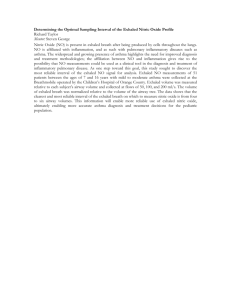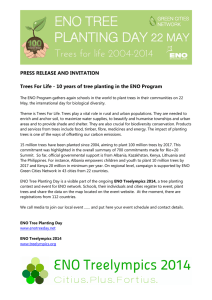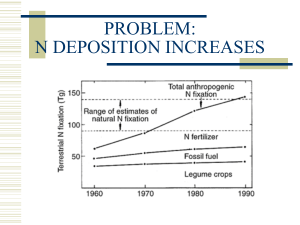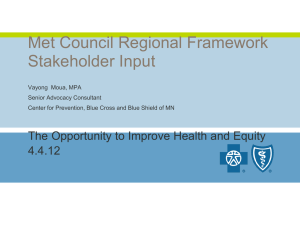It`s Not Just for Asthma Anymore! – Angela Lorenzo MS, RRT, RPFT
advertisement
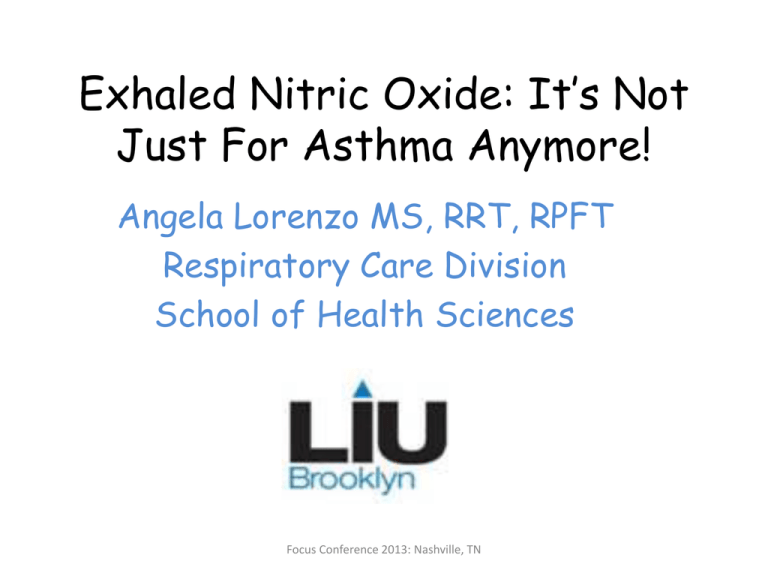
Exhaled Nitric Oxide: It’s Not Just For Asthma Anymore! Angela Lorenzo MS, RRT, RPFT Respiratory Care Division School of Health Sciences Focus Conference 2013: Nashville, TN Objectives • Utilize FeNO in PFT Lab in patients with hepatic disease of varied origin • Utilize FeNO in PFT Lab in patients undergoing radiation therapy • Involve PFT Lab and Respiratory Therapists in research opportunities Focus Conference 2013: Nashville, TN Nitric Oxide Synthase • Type I: • • • • Neuronal Nitric Oxide Synthase Type II: Inducible Nitric Oxide Synthase Type III: Endothelial Nitric Oxide Synthase Pulmonary vasculature: mainly Type II, iNOS Airways: all three Focus Conference 2013: Nashville, TN Abbreviations Used in This Presentation • • • • • • • • FeNO eNO iNOS HPS IPVD CBDL PVL RT Fraction of exhaled nitric oxide exhaled nitric oxide inducible nitric oxide synthase Hepatopulmonary Syndrome intrapulmonary vascular dilatations common bile duct ligation portal vein ligation radiation therapy Focus Conference 2013: Nashville, TN Hepatopulmonary Syndrome (HPS) • Severe liver disease of varied etiologies • Diagnostic Triad – Liver disease – Impaired oxygenation – Intrapulmonary vascular abnormalities: intrapulmonary vascular dilatations (IPVDs) • Pulmonary A-V shunts and dilation of precapillary pulmonary arteries Focus Conference 2013: Nashville, TN Liver Diseases in HPS • Many chronic and severe • But acute hepatic disease such as ischemic hepatitis • Approximately 80% patients present with symptoms consistent with liver disease • The remaining commonly present with dyspnea Focus Conference 2013: Nashville, TN Dyspnea • Dyspnea in HPS often associated with the following: – Dyspnea on exertion, rest or both – Orthodeoxia: decrease in PaO2 of > 4 mmHg when going from the supine to upright position – Platypnea: worsening of dyspnea when going from the supine to upright position Focus Conference 2013: Nashville, TN Hypoxemia • Causes of hypoxemia in liver disease can be due to – Atelectasis: mild hypoxemia • Compression of lung parenchyma by ascities, pleural fluid – Portal HTN (c/s cirrhosis): mild hypoxemia – HPS : severe hypoxemia Focus Conference 2013: Nashville, TN Etiology of IPVDs • Impaired hepatic function cannot clear circulating pulmonary vasodilators • Production of circulating vasodilators by impaired liver • Inhibition of vasoconstrictive substances with hepatic impairment Focus Conference 2013: Nashville, TN Hypothesis: Do Pts with HPS have eNO? • Cremona et al studied 12 healthy subjects, 6 pts with cirrhosis, 3 with cirrhosis and severe hypoxemia and orthodeoxia. • All 9 cirrhosis patients awaiting transplant – – – – Chronic active hepatitis (2) Cryptogenic cirrhosis (5) Primary biliary cirrhosis (1) Primary sclerosis cholangitis (1) • No one in study had evidence of airway obstruction Cremona et al Eur Resp J 1995, 8, 1883-1885 Focus Conference 2013: Nashville, TN Hypothesis: Do Pts with HPS have eNO? • Technology of the day did not allow single breath eNO measurement • 10 minutes breathing NO-free air from a 100 L Douglas bag (<1 ppb NO) • Exhaled into a second 100 L Douglas bag • Normal subjects also inhaled hypoxic gas mixture of 10% oxygen Focus Conference 2013: Nashville, TN Hypothesis: Do Pts with HPS have eNO? • All test subjects had CXR, Spirometry and DLCO, Pulsoximetry • All subjects had nml CXR and spirometry Focus Conference 2013: Nashville, TN Focus Conference 2013: Nashville, TN Hypothesis: Do Pts with HPS have eNO? • Normal subjects breathing the hypoxic gas mixture did not have an increase in eNO • One cirrhotic patient underwent lung transplant during the study • This subject’s eNO decreased after transplant • Does the transplant correct the V/Q mismatch and IPVDs Focus Conference 2013: Nashville, TN Enhanced Endothelin B receptor expression, Endothelin-1 mediated eNOS and NO production in HPS • Luo, in animal studies, noted that CBDL increased pulmonary endothelial nitric oxide synthase levels – intrapulmonary vasodilatation – gas exchange abnormalities – analogous with HPS – these findings found in pulmonary artery samples, not aortic samples Focus Conference 2013: Nashville, TN Vascular NO a Component of eNO • Cremona demonstrated that NO produced by vascular endothelium is a component of eNO – Cremona et al J Apple Physio 1995, 78, 59-63 • Pearl found that hypoxemia decreased levels of NO • Both aortic and pulmonary arterial samples tested – Pearl et al J Thorac Cardiovasc Surg 2000, 119, 931-938 Focus Conference 2013: Nashville, TN Focus Conference 2013: Nashville, TN Both O2 and NO compete for binding on hemoglobin (on same heme iron sites) NO binds faster than CO or O2 Focus Conference 2013: Nashville, TN Exhaled NO and Oxygenation Pre /Post Liver Transplantation in Cirrhosis • Rolla studied 20 patients with cirrhosis and no history/risk factors for cardiopulmonary disease before and after liver transplant • After transplant – exhaled NO decreased – A-a DO2 decreased – 5 Pts with HPS- no longer evident as demonstrated by contrast-enhanced echocardiography prior to surgery Rolla Ann Int Med 1998; 129: 375-378 Focus Conference 2013: Nashville, TN Focus Conference 2013: Nashville, TN Exhaled NO and Oxygenation Pre /Post Liver Transplantation in Cirrhosis • Impaired oxygenation in cirrhosis is often corrected with transplantation • Decrease in exhaled nitric oxide concentrations correlates with improved oxygenation • Role of nitric oxide in cirrhosis • Role of nitric oxide in identifying patients at risk of developing HPS Focus Conference 2013: Nashville, TN Predictive Value of eNO in Radiation Pneumonitis • Radiation pneumonitis is a dose-related toxicity of radiation therapy for – – – – – lung cancer breast cancer mesothelioma esophageal cancer or any radiation treatment of the thorax • Inflammatory response in normal lung tissue in response to radiation injury Guerrero; Int J Radiation Oncology Biol Phys 2012 981-988 Focus Conference 2013: Nashville, TN Predictive Value of eNO in Radiation Pneumonitis • Symptoms can occur up to 6 months after treatment ends – Cough – Dyspnea – Fever – Changes in pulmonary function Focus Conference 2013: Nashville, TN Predictive Value of eNO in Radiation Pneumonitis • Guerrero reviewed 28 patients undergoing RT for esophageal cancer • eNO measured – prior to therapy – at completion of last RT session – 6 weeks after the last RT session Focus Conference 2013: Nashville, TN Predictive Value of eNO in Radiation Pneumonitis • eNO was elevated in all patients after RT who subsequently developed radiation pneumonitis • Dose-related • eNO was elevated weeks to months PRIOR to symptoms appeared • Koizumie had similar findings in lung cancer patients undergoing RT Focus Conference 2013: Nashville, TN References • Cremona G., Higenbottam TW et al; Elevated exhaled nitric oxide in patients with hepatopulmonary syndrome. Eur Respir J 8: 1883-1885, 1995 • Cremona G, Higenbottam TW et al; Exhaled nitric oxide in isolated pig lungs. J Appl Physiol78: 59-63, 1995. • Pearl JM, Nelson DP et al; Acute hypoxia and reoxygenation impairs exhaled nitric oxide release and pulmonary mechanics. J Thorac Cardiovasc Surg. 119: 931-938, 2000. • Le Cras TD and McMurtry IF; Nitric oxide production in the hypoxic lung; Am J Physiol Lung Cell Mol Physiol 280: L575-L582, 2000. • Guerrero T, Martinez J et al; Elevation in exhaled nitric acid predicts for radiation pneumonitis. Int J Radiation Oncology Biol Phys 82: 981-988, 2012 Focus Conference 2013: Nashville, TN References • Delclaux C, Mahut B et al, Increased nitric output from alveolar origin during liver cirrhosis versus bronchial source during asthma. Am J Respir Crit care Med 165: 332-337, 2002 • Rolla G, Brussino L et al, Source of exhaled nitric oxide in primary biliary cirrhosis. Chest 126: 1546-1551, 2004 • Rolla G, Brussino L et al, Exhaled nitric oxide and impaired oxygenation in cirrhotic patients before and after liver transplantation. An Int Med 129: 375-378, 1998 • Lou B, Liu L et al, Increased pulmonary vascular endothelin B receptor expression and responsiveness to endothelin-1 in cirrhotic and portal hypertensive rats: a potential mechanism in experimental hepatopulmonary syndrome. J Hepatology 38: 556-563, 2003 Focus Conference 2013: Nashville, TN
